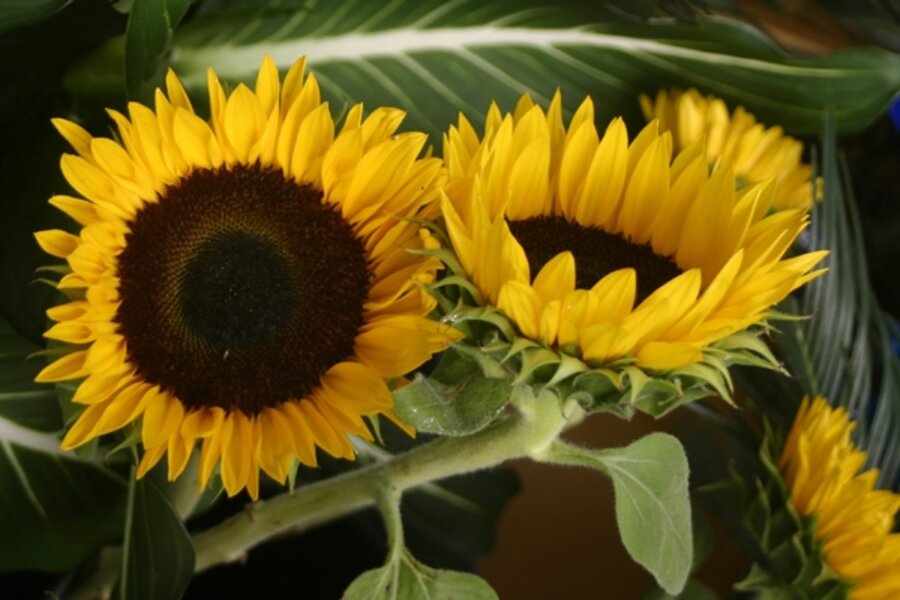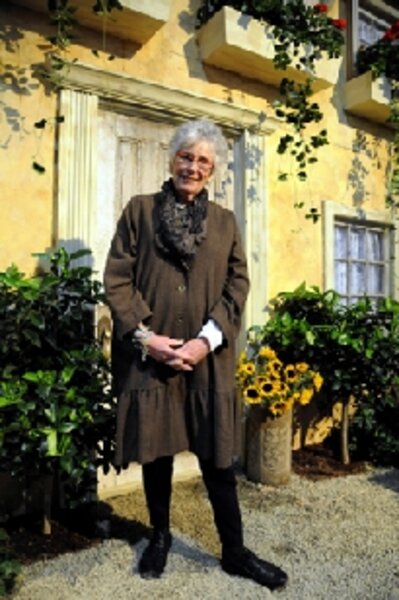Expert judgment at the Philadelphia Flower Show
Loading...
| Philadelphia
By the time Philadelphia says “arrivederci” to Bella Italia on Sunday, about a quarter million tourists will have stepped through her Roman arches, strolled past her Venetian wedding scene, envied her vegetable gardens, and ogled her opulently laid feasts. Italy is this year’s theme at the Philadelphia Flower Show, the giant redwood of such shows, the Olympic Games of horticulture.
Every visitor is an expert here, dropping, like petals, a trail of judgments about the authenticity of this 25-foot dogwood, or the appropriateness of that color stucco next to terra cotta.
And for validation of their horticultural acumen, visitors look to the pronouncements of the official judges – the American Beauties, if you will, in a world of wildflowers. Aha – you were right about that garden path – there’s the silver bowl. Here – here’s the blue ribbon. There’s the comment card that reads, simply, “WOW!!”
Judge Ginny Purviance is one of those charged with deciding what constitutes a Philadelphia Flower Show “wow.” She arrived at the cold and cavernous Philadelphia Convention Center late last week during setup. The air was sweet with mulch, and armies of workers moved plywood and rock and trees and sod hither and yon, constructing what would evolve into a show that’s a little bit marketplace, a little bit 4-H competition, and a whole lot of drop-dead, life-sized samplings of Italian life.
Deftly dodging it all, Ms. Purviance, in her red-rimmed glasses and leopard-print scarf, set off in search of perfection. One of 160 judges in the nation’s oldest and largest horticultural extravaganza, her job is to reward the best, yes, but in the process to educate exhibitors and viewers in the hallmarks of a winner.
“Your eye doesn’t want to be assaulted,” she explained at one stop in the academic display area. “It wants to be rested.” She found the country garden “very nicely done” with an interesting villa, an inviting terrace, nice flow, and a good mix of plants in top condition. And there’s good open space. Her one concern? That the exhibitors might litter their masterpiece with too much signage – a common flaw in educational exhibits.
She also found a roof garden thoughtfully exhibited at waist height, with access through a path up the middle. But she cautioned that roof gardens, while fashionable, are “very hard to achieve.”
But ethics dictated she avoid a certain area of the 10-acre floor until Saturday morning – the “display garden – floral” area (a new category here this year showcasing very sophisticated floral arrangements, separate from the usual “display garden – landscape” category that focuses more on grasses, trees, and shrubs). These exhibits are usually the showstoppers, and this year Purviance is chairing a three-judge panel charged with critiquing them. Previewing or learning the identity of an exhibitor you’re judging are flower show no-no’s.
Still, judges can sometimes tell who created a display, even with the signs covered. “If you’ve been doing it a while, you recognize a style,” she says. One tends to feature orchids; another has a characteristic lack of restraint.
• • •
Expert judging “gives the show credibility,” says Jane Pepper, president of the Pennsylvania Horticultural Society, which produces the Philadelphia show. Widely considered the best of its kind, the 180-year-old production will add an estimated $35 million in business to the region this week, from tourism, vendor sales and show costs – not to mention kindling spring fever in all manner of Saturday diggers. The show also underwrites the countless projects of Philadelphia Green, the Horticultural Society’s urban revitalization program.
The economic boon is especially welcome this year, when many shows nationwide have had to cancel, close, or look for buyers. While a win here might bring some extra business to a florist or landscape designer, participation itself is the honor, conveying status on judges and exhibitors alike.
Judges come from renowned institutions, traveling here at their own expense, and – in many cases packing considerable egos with their sensible shoes. But Philadelphia discourages the hotshot. The show prints a Sunday-school list of virtues it expects from its judges, among them charity, humility, courtesy, and sincerity. Exhibits are judged not against opponents but against a perfect score that indicates how well exhibitors achieve a stated intent while demonstrating creativity, world-class horticulture, and sound design basics.
In addition to consensus, judges must find something nice to say about each entry and are expected to justify their decisions, so entrants can do better next time. Critiques of amateur entries – “wordsmithing,” Purviance calls them – often are as creative as the displays themselves. Critiques of commercial exhibits, which may affect a firm’s business, are not posted.
Even for the worst-of-class entries, scores go only as low as they must to differentiate entrants. After all, it is no small accomplishment to exhibit here, and forces outside an entrant’s control can cause the grass to yellow or the camellias to wilt.
Word of a nasty or stubborn judge quickly gets back to management. “That person is probably not going to be invited back,” says Ms. Pepper.
Purviance, a native of Philadelphia with a landscape design degree from Radcliffe College, has been invited back 20 times since her first invitation from Pepper. Purviance exhibited at the show during her garden club years in Chestnut Hill and, before she retired, owned an interior landscaping business in Rhode Island, where she co-chairs the Newport Flower Show.
“You have to give,” says Purviance, of the morning-long judging process, when there’s a time to stick to principle and a time to keep the peace. One panel member might convince others, for example, that a featured plant material was exotic and different and hard to raise, thus deserving extra points. If in a bind, judges consult Pepper or show designer Sam Lemheney for advice. Purviance tells of a therapist friend judging elsewhere whose panel was so divided that – even after he’d put his best professional skills to work – they could not agree. The category went without a winner. “That wouldn’t happen in Philadelphia,” Purviance asserts.
This year there are points for a “wow factor.” Purviance, whose requisite flower show virtue of charity is time-tested, says subjective situations such as this can require more charity than others.
“Sometimes you ask, ‘What were they thinking?’” She describes one exhibit that came complete with a hot tub full of bubbling red water. “I thought it looked like the fires of hell,” she recalls. “If you try to glitz it up too much, you’re not going to get my vote.” Again, and with the barest sniff: “This is Philadelphia.”
Then, demonstrating on a partly finished display, she models the art of the honest compliment. She bends over and declares the ground material “jarring,” then dryly suggests that an odd component might be “some sort of an art piece, do you think?”
Then she steps back, finally sees that the display is designed in the overall shape of a flower, and is satisfied: “That’s an original idea.”
She is concerned that an entrant nearby may lose points because its black-eyed Susan and viburnum bloom a season apart, longer than show rules allow. She points out that sweet peas in another garden are harder to force in this climate than the traditionally temperamental orchids, and thus would qualify for more points, on her chart, at least. And notice the bit of dirt on a bedding plant leaf? That will be cleaned off before showtime, she predicts.
And what makes a winner? “You know it when you see it,” says the judge, who has for decades inspected estate grounds and country inns, ancient ruins and crumbling churchyards, barns and gatehouses, ponds and dollhouses. The all-time standout, for this critic, featured nothing more than an old shack tucked into forest, inspired by the nearby New Jersey Pine Barrens. “It was so simple, the message: This is what the Pine Barrens are, this is what lives here.”
As they’d say in Philadelphia, “Bella.”






